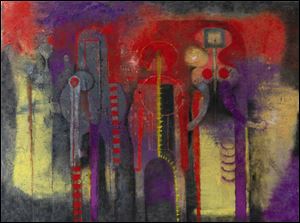
Myriad objects rescued by New York sanitation workers
7/29/2012
This image provided by Sotheby's auction house in New York shows the 1970 painting, "Tres Personajes" (Three People), by Mexican artist Rufino Tamayo. The abstract painting was found, lying in trash on the street on Manhattan's Upper West Side, could be worth up to $1 million.
NEW YORK -- On 99th Street between First and Second Avenues in Manhattan, just a few blocks from some of the city's most palatial homes, the air is tinged with a certain sourness. There is a Sanitation Department garage where giant orange trucks snooze in a dark ground-floor space. More than a dozen white garbage trucks sit in rows outside.
This two-story brick building is nothing special, even a bit decrepit, but as you walk up its crooked metal staircase toward the second floor, you will find the first hint that something wholly different, even a little dazzling, hides amid all that dingy gray: a painting of perky pink flowers on a Big Bird-yellow background hanging in the stairwell. It looks like the sort of thing that should hang on a nursery wall. And in fact, it probably once did.
The second floor of this garage, long deemed too weak to support vehicles, has become a gallery of sorts, home to hundreds and hundreds of paintings, photographs, posters, and objects, neatly framed and mounted on the walls. They are varied in every way -- from style to age to material -- except for one: Almost every last piece of the collection was rescued from household trash by New York City's sanitation workers as they went along their daily routes.
Over here is a portrait of a grumpy-looking Winston Churchill, and over there, a very nice pastel copy of Henri Matisse's "Woman With a Hat." There are photographs of the Brooklyn Bridge, landscapes done in watercolor, ancient tricycles and toy trucks, and four electric guitars, one without pickups, another without strings, arranged around a Michael Jackson poster and gold-sequined tie. There is even a Master of Business Administration diploma from Harvard hanging by a window.
And, in the midst of it all, is a hand-painted sign that reads, "Treasure in the Trash by Nelson Molina."
"I would call it more than a gallery," said Robin Nagle, who teaches at New York University and is the anthropologist in residence at the Sanitation Department. "Maybe a collection, a museum, an archive. Maybe we need a new word. Maybe he'll become a word! 'Hey, you've made a Molina!'"
Sanitation workers are not permitted to take things for their personal use, though officials and workers say it does happen. Mr. Molina's collection, however, is on display for other workers, a department spokesman explained, so it does not break the rules.
Mr. Molina, 58, a lifelong New Yorker and a sanitation worker since 1981, began collecting pictures and trinkets along his route about 20 years ago, he said, to brighten up his corner of the garage locker room. Gradually, his colleagues began to contribute, gathering up discarded gems they thought he might enjoy. As the collection grew, word spread, and workers from other boroughs started to drop off contributions from time to time. Next, building superintendents along Mr. Molina's route started putting things aside they thought he could use.
Today, he estimates he has close to 1,000 pieces in his collection, arranged with great thoughtfulness, and even humor, in an enormous open room against cream-colored brick. (He painted the walls, mixing together beige, ivory, white, and every other light-colored paint he and his colleagues could find, he explained, so that the pictures would pop.)
"Why do I do it?" Mr. Molina asked. "Because I love collecting stuff, I love hanging stuff, and I love to decorate."
Though he gets plenty of help digging for garbage gold, it is only Mr. Molina who decides what is worthy of display, who makes the frames, and who puts them up. He has no grand theories about what qualifies, he said, only his gut. Asked whether something had to be aesthetically pleasing, he laughed and pointed to a bedraggled stuffed raccoon housed inside a bright purple cage.
Mr. Molina is partial to a shelf in the locker room cluttered with small porcelain teapots, and to a scrawl of "Become Your Dream," penned, he said, by the artist De La Vega.
"It doesn't matter what it is. As long as it's cool, I can hang it up and I've got a place for it," Mr. Molina said, as he casually straightened a frame. "That's why I tell the guys, just bring it in and I'll decide if I can hang it."
In his many years of collecting, he said, he has learned two things: that household trash yields the greatest treasures, and that neighborhoods matter.
"The wealthier the neighborhood, the better the stuff that's thrown away," Ms. Nagle said.